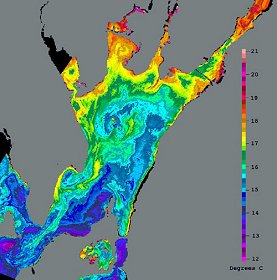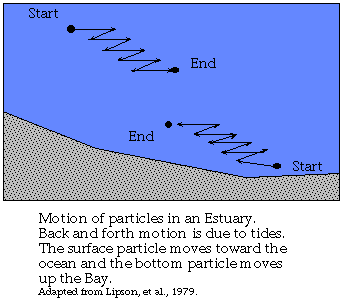 | ||||
 |
Estuarine ScienceCurrentsCirculation is the movement of water. Circulation in Narragansett Bay is the result of a complex combination of forces produced by the tides, wind, and differences in water density. In an estuary, the basic circulation is a result of fresh water entering at the head of the estuary and flowing toward the ocean. Fresh water stays at the surface as it flows seaward because fresh water is less dense than seawater. However, the fresh water will be mixed with the seawater, producing a range of salinities through the estuary. Seawater will enter the estuary at depth and flow up the estuary. Estuaries are classified by their circulation pattern. Narragansett Bay is a well-mixed estuary in the lower two thirds while the Providence River is often stratified.  Image courtesy of Dr. John Mustard, Brown University (Click for larger image) The thermal remote sensing image above shows Mt. Hope Bay in the middle of the afternoon. You can see a current of warmer water from Mt. Hope Bay moving into the relatively colder Narragansett Bay water in the lower left corner of the image. In Mt. Hope Bay, you can see several currents from the rivers draining into the Bay and from the tidal flow. The red streak in Mt. Hope Bay is a plume of warm water coming from the Brayton Point Power Plant. The most obvious currents in the Bay are tidal. These currents are caused by the movement of water as the tides ebb and flow. Tidal currents often reach their highest speed midway between high and low tide. In Narragansett Bay tidal currents of 1.5 knots (77 centimeters per second) are common. The size of the tidal current is related to the tidal range. During spring tides, higher tidal current speeds can be expected. The tidal current is slowed by friction near the bottom and the shore. The highest speeds will be found in the middle of the Bay. The shape of the Bay and the seafloor also influence the tidal currents. Narrow passages will cause a faster current. Tides slosh water back and forth. Water from the upper Bay is not moved out into Rhode Island Sound by a single outgoing tide. A barrel floating in the Providence River would be carried a few miles down the Bay by the outgoing tide and then be carried back up the Bay by the incoming tide. The barrel would end up a short distance down the Bay after one tidal cycle (ignoring all other influences on the barrel). Tides and tidal currents can also cause some vertical mixing of the water column.  Nontidal currents are caused by the flow of fresh water into the Bay and the density differences that result. Nontidal currents move slowly, at less than 0.5 knots (10 centimeters per second). Nontidal currents gradually flush water from the Bay into Rhode Island Sound. In Narragansett Bay the winds can be an important part of the circulation pattern in the Bay. Winds can dominate the flow, producing flows different than the normal current. The winds are quite variable and can only be predicted in general terms. Southerly winds will push water to the head of the Bay and northerly winds will push water out of the Bay. Winds will also contribute to vertical mixing of the water column.
|
|||